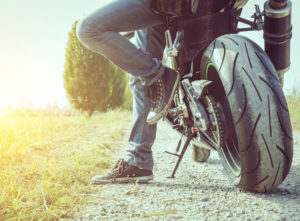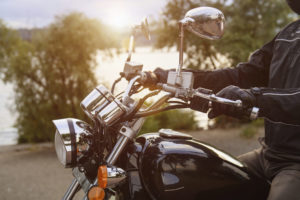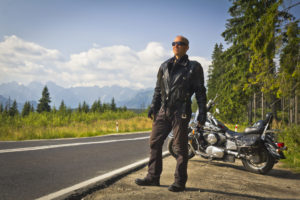You’ve decided to take a motorcycle road trip for the first time. You won’t have to spend money on airfare and the gas mileage on your bike beats that of any car. Whether you’re crossing over a couple state lines or riding across the country, there are a few things to keep in mind. Taking a motorcycle road trip is different from going on a long ride. Keep the following tips in mind to avoid headaches or accidents. And make sure you have Motorcycle Insurance!
A Bike Is Not a Car
 Five or six hours in a car may not seem so bad, but on a bike it may get very uncomfortable. If you’ve never taken a trip longer than three hours, you’re probably underestimating how grueling a long ride can be on a bike. Before setting out to ride across the country on your motorcycle, take a four-hour mini trip just to see what it feels like to be on the road that long. The more experience you have going long distances, the better. After a mini motorcycle road trip, you may end up scrapping the idea of going across country altogether. Or you may just create an itinerary with many stops along the way.
Five or six hours in a car may not seem so bad, but on a bike it may get very uncomfortable. If you’ve never taken a trip longer than three hours, you’re probably underestimating how grueling a long ride can be on a bike. Before setting out to ride across the country on your motorcycle, take a four-hour mini trip just to see what it feels like to be on the road that long. The more experience you have going long distances, the better. After a mini motorcycle road trip, you may end up scrapping the idea of going across country altogether. Or you may just create an itinerary with many stops along the way.
Windshields Add Comfort
You may like the look of your bike without any cumbersome attachments. However, being on the highway for hours without a motorcycle windshield is the most ill-advised thing a rider can do. Not only are the winds too much to tolerate for long periods, you’re absorbing dust and whatever else is blowing right at you. Avoid exhaustion from being battered by winds and keep yourself as clean as possible by using a windshield if you’re traveling for hours on your bike.
Don’t Strain Yourself
 What may seem like a comfortable riding position when you take quick rides here and there may prove to cause terrible strain on your back, neck and shoulders over the course of hours of riding. It may not be a bad idea to ride very mindfully for a while to see if you’re straining any muscles with your seat position. You can always reposition your seat to alleviate that strain.
What may seem like a comfortable riding position when you take quick rides here and there may prove to cause terrible strain on your back, neck and shoulders over the course of hours of riding. It may not be a bad idea to ride very mindfully for a while to see if you’re straining any muscles with your seat position. You can always reposition your seat to alleviate that strain.
Many hours spent riding in a less-than-ideal position could throw your back out as soon as you arrive at your destination. So, don’t be hesitant to pull off to the side of the road to readjust if you notice tension in any parts of your body. Taking lots of breaks when riding long distances on a motorcycle is highly recommended. Riding a motorcycle is much more demanding on the body than most people assume. Make sure you stop and walk around every couple of hours, too.
Also, if you’re not using a windshield, you’re straining against the force of winds. This will also eventually cause aches and pains. Check your load if you’re not riding comfortably. Keep the weight of your stuff as close as possible to the bike’s center of gravity, low and towards the tank. Don’t load one side heavier than the other. Make sure they are both equal.
Be Prepared to Face the Weather
Count on it raining during your motorcycle road trip. The chances of precipitation are high when you cross state lines. Dress appropriately for a good soak, in case you ride into a puddle or if it downpours. Don’t wear your coolest jeans and your most expensive motorcycle jacket. Dress in your worst and make sure you have a change of clothes in case you get wet. Keep your extra clothes in a waterproof bag or wrapped in trash bags so they stay dry. Consider wearing clothes that you can throw away after the long drive without a care.
Also, you should count on being too hot, both from the motorcycle and the sun. It will probably also be too cold (especially if you got wet). You’re not protected much from the elements on a bike so dress protectively and layer so that you can take some clothes off if you’re stifling from overheating.
Get Bluetooth
 You won’t be able to use your phone. And you’ll wish you could follow GPS directions, call to say you’re running late or just tune out all the noise with your favorite songs. With Bluetooth you can do all that safely. It’s worth it, so don’t go without it on your motorcycle road trip.
You won’t be able to use your phone. And you’ll wish you could follow GPS directions, call to say you’re running late or just tune out all the noise with your favorite songs. With Bluetooth you can do all that safely. It’s worth it, so don’t go without it on your motorcycle road trip.
If you haven’t done much highway riding, keep in mind that it can be a little bit terrifying and very noisy. So, you should also bring ear earplugs. You’ll still hear everything even with the most amazing earplugs. Make sure to wear your helmet too, even if you pass through states where it’s not required by law.
What to Pack on Your Motorcycle Road Trip
- Synthetic T-shirts and underwear that can be washed and dried overnight. Roll these instead of folding them to make more room for other items.
- Sparse toiletries. Take only the essentials.
- Pack rain gear, especially rain gloves, and clothing for cold weather, even if you’re counting on sunshine and mild temperatures.
- Don’t forget plastic bags and garbage bags, which can double as rain boots.
- Towels, including a few little ones.
- Bring a tool kit if you’re used to fixing problems on your ride. Expect problems. If you’re going to have to find a garage for every little thing that gets loose, maybe a long motorcycle road trip won’t be so much fun for you.
 A battery pack or Mobile Power Station. There’s nothing worse than having no cell charge or not being able to use GPS when you have no idea where you are.
A battery pack or Mobile Power Station. There’s nothing worse than having no cell charge or not being able to use GPS when you have no idea where you are.- Quarters for laundry and a handful of laundry detergent pods.
- Bring wet wipes because you will get dirty. Also, bring travel size shampoo, toothpaste etc. in case the motel doesn’t have these for free.
- An extra gallon of gas in case you lose your way.
Safety and Motorcycle Insurance
If you live in California and are used to lane-splitting, you may very well end up getting a ticket in another state if you do it. Or, you may cause an accident. Brush up on local rules for bikers and make sure you have adequate Motorcycle Insurance. Motorcycle Insurance rates are usually less expensive than Car Insurance rates. Using a trusted Insurance Specialist, you should be able to get reliable, thorough coverage at the lowest prices. Call (855) 919-4247 to speak with an agent today.
The information in this article was obtained from various sources. This content is offered for educational purposes only and does not represent contractual agreements, nor is it intended to replace manuals or instructions provided by the manufacturer or the advice of a qualified professional. The definitions, terms, and coverage in a given policy may be different than those suggested here and such policy will be governed by the language contained therein. No warranty or appropriateness for a specific purpose is expressed or implied.


